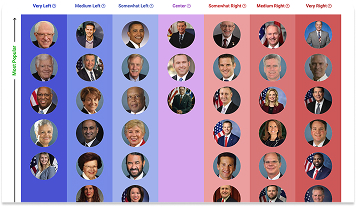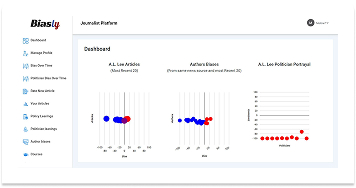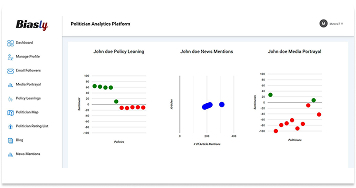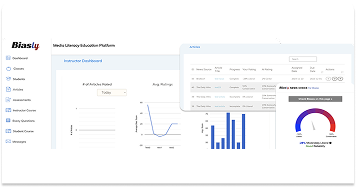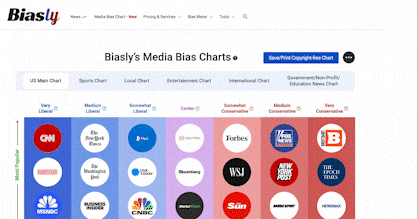Bias Meter
Extremely
Liberal
Very
Liberal
Somewhat Liberal
Center
Somewhat Conservative
Very
Conservative
Extremely
Conservative
-100%
Liberal
100%
Conservative

Biasly determines media bias ratings through a dual-layered approach combining artificial intelligence and analyst review. The platform’s proprietary bias detection engine, Bias Meter, evaluates sentiment, policy position alignment, and language framing across thousands of data points in news articles. Analysts then verify and interpret the AI’s findings, providing additional context where needed. Learn more
- Profile
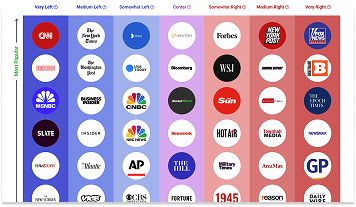
Vox on the media bias chart
Vox has a Bias Score of -46% Medium Left which is based on a variety of factors including its policy and politician leanings, article ratings, and the use of biased language. Its Reliability is rated as Good, and additional analytical insights are available in the other tabs.
- Bias Rating
-46% Medium Left
- ReliabilityPolicy Leanings
-2% Center
Extremely
LiberalVery
LiberalModerately
LiberalSomewhat Liberal
Center
Somewhat Conservative
Moderately
ConservativeVery
ConservativeExtremely
Conservative-100%
Liberal100%
Conservative
Good Reliability
*Our bias meter rating uses data science including sentiment analysis, machine learning and our proprietary algorithm for determining biases in news articles. Bias scores are on a scale of -100% to 100% with higher negative scores being more liberal and higher positive scores being more conservative and 0% being neutral. The rating is an independent analysis and is not affiliated nor sponsored by the news source or any other organization.
Politician Portrayal78% negative
Continue For Free
Create your free account to see the in-depth bias analytics and more.
By creating an account, you agree to our Terms and Privacy Policy, and subscribe to email updates.
Policy Leanings Analysis
Policy | Bias score |
|---|
Vox Editorial Patterns
Vox’s coverage of political topics often reflects a Medium Left bias, with consistent patterns in phrasing, source selection, and thematic focus that are Moderate Left. While the publication demonstrates journalistic standards in many of its reports, issue selection, framing, and word choice can indicate a political slant. This content analysis examines how Vox handles liberal and conservative issues and evaluates its language choices and editorial tendencies.
Coverage of Liberal vs. Conservative Topics
Vox’s articles include topics like immigration, government funding, and the Israeli-Palestinian conflict. Their articles tend to favor liberal viewpoints and policies. For example, in the article “Jimmy Kimmel’s return showed the potential — and limits — of celebrity resistance”, the liberal position is portrayed in a very positive light:
“Second, it was also a new kind of (partial) victory for liberals and their resistance efforts in the second Trump term. Led by celebrities, podcasters, influencers, and the grassroots — as opposed to any institutions, corporations, billionaires, or political parties — it managed to get a major corporation to resist Trump and restore Kimmel, even though his show is only returning to about three-quarters of the ABC-affiliated TV stations in America.”
Words like “victory” and “resistance efforts” signal that the article is somewhat rooting for the liberal perspective. The celebratory framing and evaluative terms indicate a liberal bias.
On the other hand, conservative politicians and policies are often framed critically. For example, in the article “The real reason Democrats forced a government shutdown” Trump is portrayed in an overtly negative manner:
“The most important bit of context for the present crisis is Trump’s creeping authoritarianism. Trump has launched pretextual investigations against his enemies, awarded pardons and military honors to his insurrectionary friends, extorted television networks into suppressing critical journalism and comedy (with mixed success), deported longtime US residents without due process, and vowed to crack down on progressive organizations in the name of counter-terrorism.”
The accusatory diction (e.g., “creeping authoritarianism”) signals a critical perspective on the Trump administration’s usage of executive power. This indicates a liberal leaning.
Policy and Issue Framing
On LGBTQ+ rights, conservative policies are frequently portrayed critically, while liberal policies receive favorable framing. In the article “Trump promised to be LGBTQ-friendly. His first year in office proved it was a giant con.”, Trump is viewed negatively, while Obama’s policies are praised:
“In its first year, the Trump administration has tried to reinstate a ban on transgender people in the military. It has nominated multiple people to the courts and elsewhere who have anti-LBGTQ records. It has directed its army of federal lawyers to take the anti-LBGTQ side in court cases. And it has done some extraordinarily petty things, like refusing to recognize Pride Month.”
By framing Trump’s handling of LGBTQ+ issues from the perspective of its effects on marginalized groups, the article aims to be critical of Trump’s policies.
“Obama became the first sitting president to support same-sex marriage. His administration interpreted civil rights law to protect trans people where other existing laws failed to. It reversed “don’t ask, don’t tell”, which banned gay people from serving openly in the military, and began to reverse a similar ban on open trans service members. In court cases in which it chimed in, the Obama administration was a reliable ally of LGBTQ rights causes.”
By placing Trump’s actions against LGBTQ+ members first, Obama is contrasted to this image and comes off much more positively. He is also framed as an “ally”. The contrast in evaluative language indicates a left-leaning bias.
With issues like tariffs, the focus is to criticize conservative policies, rather than provide multiple perspectives neutrally. For example, in the article “Trump’s new tariffs will slam America’s already brutal housing crisis”, the article only focuses on criticizing Trump’s policies:
“Housing in America is about to get more expensive, thanks to new tariffs imposed by President Donald Trump that will take effect this Wednesday, October 1.”
While the claim may be accurate, balanced coverage would include countervailing evidence and economic nuance.
Coverage and Relevance
Vox’s reporting often touches on key issues central to the media political bias discussion, including racial justice issues, climate change, and gun rights. As such, it serves as a compelling case study for examining source bias and news media bias in issue-focused reporting.
Readers who wish to further explore how Vox compares with other publications can visit Biasly’s Media Bias Chart to analyze tone and word choice in real time.
Vox Bias Analysis
Vox was founded in 2014 with this goal in mind:
“The media did a good job of reporting the news and commenting on it, but there was a disconnect between that work and the audience truly understanding why something happened. Vox started as — and remains — an organization dedicated to addressing that gap, which not only persists but has grown.”
As of August 2025, the Vox website had 6.5 million visitors according to Semrush. However, Vox Media as a whole reportedly had 175.4 million viewers in June 2022. As a leading national news outlet in the United States, Vox plays a significant role in shaping public perception.
This article delves into Vox’s editorial tendencies to explore whether political bias is present and, if so, to what degree.
Is Vox Biased?
Based on Biasly’s evaluations, Vox is rated as Medium Left.
By examining content patterns and the broader context of media influence, we aim to offer a balanced perspective on Vox’s political bias.
How Does Biasly Rate News Sources?
Biasly uses proprietary algorithms and a team of analysts to provide comprehensive bias evaluations across thousands of news outlets. Over 200,000 articles from more than 3,200 sources have been analyzed to identify the most accurate and unbiased stories.
Biasly assigns each outlet three key scores:
- Reliability Score – Reflects factual accuracy
- AI Bias Score – Generated via natural language processing
- Analyst Bias Score – Assessed by human political analysts
These scores are based on seven core metrics: Tone, Tendency, Diction, Author Check, Selection/Omission, Expediency Bias, and Accuracy. These elements help analysts and algorithms evaluate the political attitude conveyed by each article.
Biasly’s Bias Meter ranges from -100% (most left) to +100% (most right), with 0% indicating neutrality. The system evaluates individual articles based on political terms, policies, figures, and sentiment to calculate precise bias ratings.
Is Vox Politically Biased?
Vox earns a Medium Left rating for its AI Bias Score and a Somewhat Left for its Analyst Bias Score. The Analyst Bias Score is generated by reviewers from liberal, moderate, and conservative backgrounds. Biasly analysts reviewed multiple Vox articles and noted preferences in coverage of liberal politicians and policy topics. For example, the article “RFK Jr. is running a dangerous experiment on all of us” signals a liberal bias in terms of vaccination policy:
“President Donald Trump and Health Secretary Robert F. Kennedy Jr. are now warning pregnant women to avoid Tylenol — yes, Tylenol — because of its supposed link to autism. Never mind that there’s no strong scientific evidence to back that up. It’s just the latest example of a clear trend in this administration: ideology-first policymaking.”
Even if these claims are accurate, neutral framing would present competing perspectives. This is done by presenting both ideological perspectives and allowing the reader to come to a conclusion on their own. The language in this quote skews the reader’s conclusion to favor a liberal policy position.
Analysis of Bias in Vox Online Articles
To evaluate bias, we can analyze select Vox articles through several of Biasly’s bias rating criteria: Tone, Tendency, Author, Diction, and Expediency Bias.
- Tone: The overall attitude conveyed by the article
- Diction: Specific word choices made by the writer
- Author: The background and social presence of the journalist
- Tendency: Patterns of bias in the writer’s broader body of work
- Expediency Bias: Quick visual or textual cues (e.g., headlines and photos) that imply bias

Source: Vox
One example of expediency bias can be seen in the article “The very specific way America could become authoritarian”. While there is nothing inherently biased about the cover photo for this article, the headline uses language like “authoritarian”, which signals a left-leaning bias. Terms like “authoritarian” can be inflammatory and controversial. By using this term, it is likely that Vox is attempting to attract a liberal audience.
One example of how tone can portray bias is seen in the article “Trump’s weird day at the UN, briefly explained”:
“President Donald Trump took a chaotic, and at times, incoherent turn through the 80th meeting of the United Nations General Assembly on Tuesday, upending US policy on the Russia-Ukraine war in the process.”
By using words like “chaotic” and “incoherent,” the article aims to portray Trump as a loose cannon or out of control.
“Trump started his day with a bizarre speech to the assembled world leaders, at times attacking other countries, efforts to address climate change, and the United Nations itself. The address was noticeably light on policy and heavy on false claims.”
This evaluative language, like “bizarre,” establishes a critical tone. Rather than portraying the events as they happened and just what was said, the article attempts to critique Trump’s speech. This indicates a liberal bias.
An example of how diction can portray bias is seen in the article “This is how Trump ends democracy”. Inflammatory diction like “authoritarianism,” “weaponize,” and “bullying and bribing” in reference to Trump signals a liberal bias to the article. The lack of neutral diction in the article signals an underlying bias the author may have in favor of liberal policy positions.
Checking an author’s background can be a good way to see if there may be bias in an article they’ve written. For example, here is an X post from Vox writer Dylan Scott:
Rs are betting they can destroy the social safety net for millions of Americans and enough of them won’t notice or won’t care enough to vote on it the next time around.
There will be much rejoicing after passage today. I’ll be curious to see how this bet pays out in 5-10 years
— Dylan Scott (@dylanlscott) July 1, 2025
It is clear that, personally, Scott may hold policy positions that do not agree with conservative policies. This suggests, but doesn’t guarantee, that Scott’s articles may lean liberal.
Another way to analyze bias is to view previous articles that an author has written. For example, here are the headlines from some of the articles Zack Beauchamp has written:
- “The third Red Scare”
- “This is how Trump ends democracy”
- “The very specific way America could become authoritarian”.
Through these headlines, it may suggest that Beauchamp’s articles generally have a liberal bias.
Analysis of Vox Opinion Articles
Vox does not label an explicit opinion section, so readers should distinguish analysis from straight news within individual articles.
Who Owns Vox?
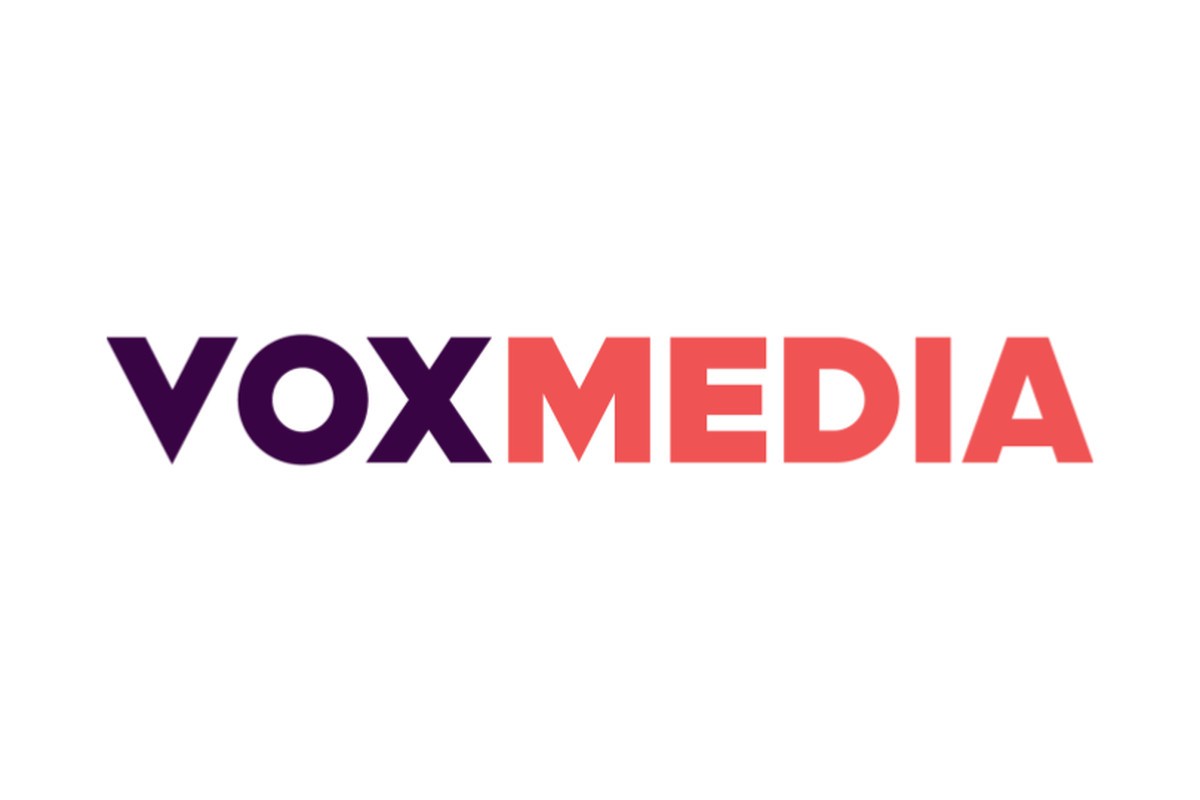
Source: Vox Media
Vox is owned by Vox Media, which has multiple stakeholders, including Penske Media Corporation and Comcast. It is important to note that Vox is a for-profit news outlet. As a for-profit outlet, commercial incentives may influence editorial strategy.
How to Evaluate Bias
Although Biasly rates Vox as Medium Left, it’s important to remember that bias can vary from article to article. Vox also covers a conservative-leaning state with objectivity on many issues, from state legislation to social developments. This complexity underscores the importance of examining each article individually. So, let’s learn how to evaluate media bias.
Recognizing media bias requires awareness and critical thinking. Often, readers trust news sources that affirm their existing beliefs, a psychological tendency known as confirmation bias. This makes it harder to identify slanted narratives or one-sided reporting.
To combat this, it’s essential to challenge your assumptions by consulting multiple viewpoints and verifying news through third-party analysis. Tools like Biasly’s media bias ratings allow readers to compare the same news story across the political spectrum.
Ultimately, bias isn’t always a matter of what is said; it’s also about what is left out, how topics are framed, and which stories are chosen for coverage. Learning to recognize these patterns can help readers make more informed decisions and develop greater media literacy.
To start comparing news outlets and gain a better understanding of bias, sign up for Biasly’s Media Bias & News Analytics Platform to see how stories vary between sources.
Vox Reliability Analysis
Is Vox Reliable?
Biasly gives Vox a score of “Good” in terms of their reliability. This suggests that, despite their political bias, they maintain a high editorial standard. This indicates generally sound sourcing and factual support. Still, one must be wary of political bias and how issues are framed.
Further investigation is needed to determine whether bias or other factors are affecting its accuracy. At Biasly, we specialize in evaluating not just bias but also the reliability of media outlets. Let’s explore the accuracy and trustworthiness of Vox.
How to Evaluate Reliability?
Reliability refers to how trustworthy or accurate a news source is. If we can’t trust what we read, then continuing to consume content from that outlet serves little purpose. So how do we evaluate a news outlet’s reliability?
There are several potential measures of reliability to look out for when trying to determine whether a media source is reliable or not. Red flags for an unreliable article can include the presence of wild, unsubstantiated claims, facts dependent on other unreliable sources, heavy use of opinionated language, and more. In contrast, hallmarks of a reliable source include:
- Absence of subjective language
- Citing credible sources (e.g., .gov, .edu, academic references)
- Verifiable facts and statistics from multiple outlets
- Use of primary sources, like interviews or transcripts
- Consistency with coverage across other platforms
Biasly’s reliability scores incorporate these elements in evaluating media outlets.
So How Does Vox Fare in Its Reliability?
The political reliability index developed by Biasly assesses both accuracy and trustworthiness. Vox currently holds Good Reliability Score, which is calculated as a weighted average of:
- Fact Analysis Score – Evaluates the accuracy of claims, facts, and evidence.
- Source Analysis Score – Assesses the number, diversity, and credibility of sources and quotes used.
Vox’s Source Analysis Score is Good at 70% Reliable. This suggests moderate trustworthiness in its sourcing practices. The score is AI-generated and considers quote length, frequency, diversity, and quality.
The Fact Analysis Score of Vox is Good at 83% Reliable. This further shows how well Vox supports its claims, addresses selection and omission bias, and presents verifiable evidence.
While Vox leans toward factual reporting, occasional lapses—such as unbalanced viewpoints or incomplete data—can affect its reliability rating. These nuances emphasize the importance of analyzing individual articles.
Vox’s Accuracy and Reliability
According to Biasly’s analysis, Vox maintains Good Reliability Score, but individual articles may vary significantly. Let’s dive into the details.
Two common types of bias that affect factuality include:
- Selection Bias – Highlighting or omitting stories to fit a particular narrative.
- Omission Bias – Leaving out differing perspectives or relevant details to skew perception.
Biasly’s accuracy ratings use a scale from 1% (least accurate) to 100% (most accurate). Factors include the presence of supporting evidence, internal and external reliable sources, and balanced viewpoints.
Analysis of Reliability in Vox’s Online News Articles
Vox aims to serve its readers with objective, fact-based reporting. However, readers should distinguish between news reporting and opinion pieces to evaluate credibility effectively.
Quality of Sources and Facts Used
Vox often uses credible sources from across the political spectrum. However, some articles skew in how comprehensively they present opposing viewpoints.
For example, the article “The big contradiction in progressive thinking about Trump” portrays how an article’s reliability can be hurt by a lack of diverse sources. Here are the sources cited in the article:
- Ezra Klein, a New York Times Columnist and Co-Founder of Vox
- Vox, an American news outlet
- Matthew Yglesias, an American journalist
- Adam Bonica, a political scientist
- Jake Grumbach, a political scientist
- Nate Silver, a statistician
- Lakysha Jain, a pollster
- Scott Alexander, a blogger
- Jacqueline Colao, a political scientist
The article has five quotes, with one being long. While their quotes may seem scarce, the majority of their evidence is paraphrased. Klein, Vox, Yglesias, Silver, and Jain can be considered left-leaning. Grumbach, Bonica, Alexander, and Colao can be considered centrist. Due to this lack of ideological diversity in their sources, this article has a lower reliability. Articles with high reliability frame issues with multiple perspectives to portray the issue more holistically.
An article that can be considered reliable is “The Supreme Court’s newest decision could make it impossible to end the shutdown”. Here are the sources used in the article:
- John Roberts, Chief Justice of the United States Supreme Court
- Vox, an American news outlet
- William Rehnquist, former Chief Justice of the United States Supreme Court
- Elena Kagan, Justice on the United States Supreme Court
- The Hill, American political news outlet
- The New York Times, American news outlet
- HuffPost, American news outlet
The article has four quotes, with two of them being long:
“In fairness, the Republican justices’ decision does include a line suggesting that they may revisit the question of whether Trump can unilaterally repeal a federal spending law in the future.”
Rather than commenting or using critical language to frame the Republican perspective negatively, the author provides a nuanced response and aims to present the Republican perspective holistically. Therefore, despite Vox generally having a liberal bias, by presenting the opposing argument, this article can be considered centrist. Roberts and Rehnquist are considered to be right-leaning. Vox, Kagan, The Hill, The New York Times, and HuffPost are considered left-leaning. Therefore, because of the wider range of perspectives included in this article, it can also be considered to have high reliability.
Selection and Omission Bias
An example of an article that has no selection or omission bias is “Trump’s prosecution of a Democratic lawmaker is a test run for authoritarian rule”. The article provides both conservative and liberal perspectives to frame this issue. After neutrally presenting the conservative argument, the article presents the liberal counterargument:
- “McIver is charged under a federal law that targets anyone who “forcibly assaults, resists, opposes, impedes, intimidates, or interferes” with a federal law enforcement officer carrying out their official duties. There’s no question that McIver, who joined a group of people attempting to block federal agents from seizing Baraka, impeded or interfered with that arrest. But she only committed a crime if she did so “forcibly,” and the Trump administration’s claim that she did is quite a stretch.”
- “McIver’s lawyers raise two constitutional challenges to Trump’s prosecution of her. The first is that she is being selectively prosecuted for the purpose of “punishing a Democratic official for her disfavored policy views…McIver’s other claim rests on the Speech and Debate Clause, which the Supreme Court has historically interpreted very broadly to prevent law enforcement from interfering with members of Congress who are engaged in their official duties.”
By presenting both arguments, the article frames the issue to allow the reader to grasp the issue as a whole, rather than from only one perspective.
Another article that has no selection or omission bias is “The flimsy evidence behind Trump’s big autism announcement, explained”. This article also provides the arguments of both conservative and liberal viewpoints:
- Conservative viewpoint: “During a highly anticipated announcement today, President Donald Trump urged pregnant people to avoid taking Tylenol if possible because of the painkiller’s possible link to autism. At the same time, Trump promoted leucovorin, a decades-old medication that mimics folic acid and is often used to restore nutrients in patients who are taking chemotherapy drugs. The folate-based treatment has been investigated in a few small clinical trials as a possible therapeutic for children with autism.”
- Liberal viewpoint: “Of course, many autism scientists and advocates are alarmed by the administration’s announcement. The evidence linking Tylenol to autism’s development is mixed, some studies have found an association, including a cohort study based out of Boston cited by Food and Drug Administration Commissioner Marty Makary at the press conference. The cohort research involved 1,000 children; a 2024 study that covered 2.5 million children in Sweden, however, concluded that no link exists.”
By providing both arguments, the article allows the reader to understand the issue better and come to their own conclusion.
An example of selection bias is the article “The third Red Scare”. The article solely highlights conservative perspectives in a critical manner:
“Prominent right-wing voices, like Laura Loomer and the social media account Libs of TikTok, are gleefully identifying more targets — including police officers, high school teachers, and nurses. An anonymous website, called the Charlie Kirk Data Foundation, is building a blacklist based on more than 60,000 reports of allegedly unacceptable reactions to the killing.”
By highlighting only conservative statements and critiquing them, the article lacks opposing perspectives and thus reads as non-objective. Rather, by only focusing on criticizing conservative perspectives, the article is framing the issue with a liberal bias.
So, Is Vox Reliable?
Overall, Vox can be considered to be an outlet that is very reliable. It demonstrates a consistent goal of journalistic integrity and typically supports claims with sources and quotes. Occasional omissions and framing bias do appear, particularly on culturally sensitive or partisan issues.
As media literacy improves, readers can more easily detect issues with selection bias, omission bias, and factuality. To strengthen your ability to assess reliability across the political spectrum, use the News Bias Checker to compare how multiple outlets report the same story.
This empowers you to consume more accurate, balanced, and dependable news.
Additional Insights
News Source Comparison
When it comes to news source comparison, Vox is often evaluated alongside other regional and national outlets that lean left or center-left. Sources like The Guardian, Los Angeles Times, or The Seattle Times often present similar tones and editorial philosophies. While Vox maintains a Medium Left media bias, it differs from strongly partisan sources in that it occasionally includes opposing viewpoints and strives for regional coverage balance.
This puts it in contrast with more biased media outlets that present consistently one-sided narratives without factual counterpoints. Readers seeking balanced political coverage may compare Vox’s framing of issues with outlets rated as Center or Lean Right on our Media Bias Chart, or explore other regional papers on our Similar Sources page.
Notable Contributors and Authors
Vox features a diverse range of reporters and columnists, many of whom are deeply familiar with the American political and social climate. Reporters like Eric Levitz and Zack Beauchamp reflect Vox’s dedication towards analyzing systemic issues with American politics.
Related Tools and Resource Pages
To better understand how Vox fits into the broader media landscape, we recommend exploring these helpful resources:
- Media Bias Chart: See where Vox ranks among hundreds of media outlets across the political spectrum.
- Political Bias Chart: Visualize political slants of news sources across various policy areas.
- Journalist Bias Analytics Platform: Explore how individual journalists contribute to bias within their publications.
- Politician Bias Analytics Platform: Compare how politicians are framed differently by Vox and other outlets.
- Media Literacy Education Platform: Learn how to critically assess media sources, bias techniques, and news reliability.
Frequently Asked Questions
Vox is rated as Medium Left based on Biasly’s media bias algorithm, which assesses sentiment, article framing, and policy favorability.
While Vox is not widely known for promoting fake news, some articles have shown selection and omission bias, especially in political reporting. Its factual reporting is generally sound.
Biasly uses a combination of AI sentiment analysis and human analyst review to assess tone, fact accuracy, source quality, and media bias indicators. Learn more on our Bias Meter page.
Yes, but with caution. Vox typically upholds fact-based journalism, though occasional partisan framing and selective reporting may impact overall news reliability.
Ratings are based on recent news using data science and A.I. technology.
Military Spending
| Date | Sentiment | Associated Article | Snippet |
|---|---|---|---|
| 08/25/2019 | 75% For | Trump Family Detentions Flores Agreement (link) | So, of course, the Trump administration is doing the opposite in a baldfaced |


























